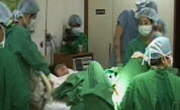Using the 2004 Korean Labor and Income Panel Study (KLIPS), this paper examines the causal effect of intergenerational family structure on the fertility of married children. Our instrumental variable (IV) estimation results show that coresidence with ...
http://chineseinput.net/에서 pinyin(병음)방식으로 중국어를 변환할 수 있습니다.
변환된 중국어를 복사하여 사용하시면 됩니다.
- 中文 을 입력하시려면 zhongwen을 입력하시고 space를누르시면됩니다.
- 北京 을 입력하시려면 beijing을 입력하시고 space를 누르시면 됩니다.
https://www.riss.kr/link?id=A104808429
- 저자
- 발행기관
- 학술지명
- 권호사항
-
발행연도
2009
-
작성언어
Korean
-
주제어
family structure ; fertility ; instrumental variable ; 가족구조 ; 출산 ; 도구 변수
-
등재정보
KCI등재
-
자료형태
학술저널
-
수록면
1-25(25쪽)
-
KCI 피인용횟수
16
- DOI식별코드
- 제공처
-
0
상세조회 -
0
다운로드
부가정보
다국어 초록 (Multilingual Abstract)
Using the 2004 Korean Labor and Income Panel Study (KLIPS), this paper examines the causal effect of intergenerational family structure on the fertility of married children. Our instrumental variable (IV) estimation results show that coresidence with parents does not have a statistically significant effect on the fertility of married children while OLS estimation results show a significant and positive effect. This implies that higher fertility of married couples living with their parents cannot be explained by childcare services provided by their parents, but by the unobservable attributes of married children.
국문 초록 (Abstract)
기존의 출산율에 관한 대부분의 논의들은 가족구조가 출산율에 영향을 미친다는 암묵적인 전제에 기초하고 있지만, 개인별 자료를 이용하여 이를 엄밀하게 검증한 연구는 이루어지지 않았...
기존의 출산율에 관한 대부분의 논의들은 가족구조가 출산율에 영향을 미친다는 암묵적인 전제에 기초하고 있지만, 개인별 자료를 이용하여 이를 엄밀하게 검증한 연구는 이루어지지 않았다. 본고는 한국노동패널 자료(KLIPS)를 이용하여 가족구조와 출산율과의 관계를 실증적으로 규명한다. OLS 추정결과에 의하면 부모와 동거하는 기혼자녀 부부일수록 더 많은 자녀를 출산한 것으로 나타났다. 그러나 OLS 추정치에는 부모와의 동거 결정과 자녀 출산 결정은 서로 영향을 주고받을 가능성이 있기 때문에 편의(bias)가 존재할 수 있다. 본고에서는 이러한 가족구조와 출산 사이의 존재할 수 있는 내생성 문제를 통제하기 위해 남편의 출생 순위를 기혼자녀 부부의 부모와의 동거에 대한 도구변수로 사용한다. 도구변수를 사용한 추정 결과에 의하면, 부모와의 동거는 기혼자녀 부부의 출산에 통계적으로 유의한 영향을 미치지 않는 것으로 나타났다. 이러한 실증분석 결과는 부모와의 동거와 출산율 사이에 나타나는 정(+)의 관계가 출산 성향이 높은 기혼자녀 부부가 부모와 동거하게 되는 선별 과정(sorting process)에 의해 발생할 수 있음을 시사한다.
참고문헌 (Reference)
1 Tsay, Wen-Jen, "The Pattern of Birth Spacing during Taiwan’s Demographic Transition" 18 : 323-336, 2005
2 Sasaki, Masaru, "The Causal Effect of Family Structure on Labor Force Participation among Japanese Married Women" 37 (37): 429-440, 2002
3 Stock, James H, "Testing for Weak Instruments in Linear IV Regression" Chapter 5 in Identification and Inference in Econometric Models:Essays in Honor of Thomas J.Rothenberg,edited by D.W.K.Andrews and J.H.Stock,Cambridge:Cambridge University Press 2005
4 Davis, Kingsley, "Social Structure and Fertility: An Analytic Framework" 4 (4): 211-235, 1956
5 Chun,Hyunbae, "Living Arrangement and Labor Supply of Married Women:An Instrumental Variable Approach" Unpublished working paper,Korea Labor Institute 2007
6 Wakabayashi, Midori, "Is the Eldest Son Different? The Residential Choice of Siblings in Japan" 2006
7 Stock, James H, "Introduction to Econometrics(2nd edition)" Pearson-Addison Wesley 421-467, 2006
8 Davis, Kingsley, "Institutional Patterns Favoring High Fertility in Underdeveloped Areas" Eugenics Quarterly 2 33-39, 1955
9 Freedman, Ronald, "Household Composition, Extended Kinship and Reproduction in Taiwan: 1973~1980" 36 (36): 395-411, 1982
10 Freedman, Ronald, "Household Composition and Extended Kinship in Taiwan" 32 (32): 65-80, 1978
1 Tsay, Wen-Jen, "The Pattern of Birth Spacing during Taiwan’s Demographic Transition" 18 : 323-336, 2005
2 Sasaki, Masaru, "The Causal Effect of Family Structure on Labor Force Participation among Japanese Married Women" 37 (37): 429-440, 2002
3 Stock, James H, "Testing for Weak Instruments in Linear IV Regression" Chapter 5 in Identification and Inference in Econometric Models:Essays in Honor of Thomas J.Rothenberg,edited by D.W.K.Andrews and J.H.Stock,Cambridge:Cambridge University Press 2005
4 Davis, Kingsley, "Social Structure and Fertility: An Analytic Framework" 4 (4): 211-235, 1956
5 Chun,Hyunbae, "Living Arrangement and Labor Supply of Married Women:An Instrumental Variable Approach" Unpublished working paper,Korea Labor Institute 2007
6 Wakabayashi, Midori, "Is the Eldest Son Different? The Residential Choice of Siblings in Japan" 2006
7 Stock, James H, "Introduction to Econometrics(2nd edition)" Pearson-Addison Wesley 421-467, 2006
8 Davis, Kingsley, "Institutional Patterns Favoring High Fertility in Underdeveloped Areas" Eugenics Quarterly 2 33-39, 1955
9 Freedman, Ronald, "Household Composition, Extended Kinship and Reproduction in Taiwan: 1973~1980" 36 (36): 395-411, 1982
10 Freedman, Ronald, "Household Composition and Extended Kinship in Taiwan" 32 (32): 65-80, 1978
11 Ogawa, Naohiro, "Family Structure, Home Time Demands, and the Employment Patterns of Japanese Married Couples" 14 (14): 677-702, 1996
12 Angrist, Joshua D, "Children and Their Parent’s Labor Supply: Evidence from Exogenous Variation in Family Size" 88 (88): 450-477, 1998
13 Chun, Hyunbae, "An Instrumental Variable Estimate of the Effect of Fertility on the Labor Force Participation of Married Women" 9 (9): 631-634, 2002
14 Becker,Gary S, "An Economic Analysis of Fertility" In Demographic and Economic Change in Developed Countries.edited by Gary S.Becker,Princeton,NJ:Princeton University Press 1960
동일학술지(권/호) 다른 논문
-
국내 단체교섭구조 및 그 결정요인과 산업별 다양성: 국제비교적인 시각의 고찰
- 한국노동연구원
- 정주연
- 2009
- KCI등재
-
- 한국노동연구원
- 황선웅
- 2009
- KCI등재
-
- 한국노동연구원
- 서병선
- 2009
- KCI등재
-
- 한국노동연구원
- 조성혜
- 2009
- KCI등재
분석정보
인용정보 인용지수 설명보기
학술지 이력
| 연월일 | 이력구분 | 이력상세 | 등재구분 |
|---|---|---|---|
| 2027 | 평가예정 | 재인증평가 신청대상 (재인증) | |
| 2021-01-01 | 평가 | 등재학술지 유지 (재인증) |  |
| 2018-01-01 | 평가 | 등재학술지 유지 (등재유지) |  |
| 2015-01-01 | 평가 | 등재학술지 유지 (등재유지) |  |
| 2011-01-01 | 평가 | 등재학술지 유지 (등재유지) |  |
| 2008-01-01 | 평가 | 등재학술지 선정 (등재후보2차) |  |
| 2007-01-01 | 평가 | 등재후보 1차 PASS (등재후보1차) |  |
| 2005-01-01 | 평가 | 등재후보학술지 선정 (신규평가) |  |
학술지 인용정보
| 기준연도 | WOS-KCI 통합IF(2년) | KCIF(2년) | KCIF(3년) |
|---|---|---|---|
| 2016 | 0.92 | 0.92 | 1.3 |
| KCIF(4년) | KCIF(5년) | 중심성지수(3년) | 즉시성지수 |
| 1.3 | 1.23 | 1.948 | 0.18 |




 KCI
KCI






